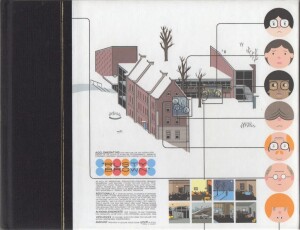 “The mass of men lead lives of quiet desperation.”
“The mass of men lead lives of quiet desperation.”
Henry David Thoreau wrote these words in his classic book Walden, in 1854. Wow — that’s 152 years ago! And, according to the characters in Chris Ware’s most recent graphic novel[ty] those lives are every bit as quietly desperate (or desperately quiet) as ever.
Chris Ware has been putting out these semi-regular volumes for quite some time. Each of the sixteen issues has arrived whenever he had one ready. This one introduces a new story — or two. The main portion of the book is taken up with the tale of “Rusty Brown,” a young redheaded boy who worships Supergirl, and thinks he has just been given the gift of super-hearing. His story unwinds in the top two-thirds of the page, and a parallel tale runs along the bottom. Before long the two stories blend together, as the characters meet at Rusty’s school (where, coincidentally, his father Woody is a teacher.) The second storyline features Chalky and Alice White (two new kids at the school) and as their timeline coincides with Rusty’s, characters and dialogue begin to appear in both strips. Each one uses the frame of reference of its main character, so Rusty’s panels show the Brown perspective while Chalky/Alice’s panels give you their side of the story. Are you with me?
Ware is very creative in his storytelling techniques. He uses flashbacks, dream sequences, and quick cutting. It’s all very cinematic. His drawing style is unique. He uses architecture, not just as settings but to propel the narrative. His characters have a precise look, as if the french curve and a compass were Ware’s constant companions at the drafting table. But never do the characters become ciphers. Each character has his or her own personality. If you’ve seen his previous work (especially Jimmy Corrigan or Quimby Mouse) you’ll know what I mean.
There is another story included in this volume, or, at least, the beginnings of one. Four double page layouts of “Building Stories” require the book to be turned sideways, and studied carefully. The warning on the front cover tells us that, “the careful reader will note a suspicious similarity of themes, ideas, and color tints, despite its being an entirely independent and intentionally remote aesthetic organism.” That’s just the way Ware talks! Or writes. You get used to it. You need to look at these pictures, and study them. The stories are there; there are no words, or very few, but by looking, by following the arrows, and using your imagination, you’ll discover many things.
We are told at the Fantagraphics website, “Though originally released by alternative comics vanguard Fantagraphics Books, this new sixteenth issue is the first to be entirely produced, printed and published by Mr. Ware alone; limited to a single press run, once it is sold out, pulped, and/or burned, neither of these narratives will be available again until ‘Rusty Brown’ and ‘Building Stories’ are eventually edited, collected and remaindered as hardcover books.” So this slim volume is a new beginning. What will happen to Rusty and Chalky? Will Woody escape? And what about Supergirl — isn’t she cold? Why is there a teacher named Mr. Ware? And why is he so weird?
This sixteenth edition of The Acme Novelty Library is a delightful, yet somewhat disturbing, introduction to some new lives of quiet desperation.
(Raincoast Books, 2005)
